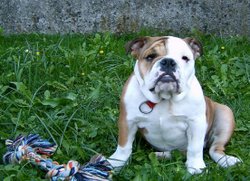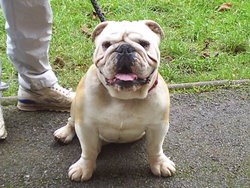
English BullDog
|
Dog breeds of the world, BullDog |
| BullDog | ||
|---|---|---|

BullDog
|
||
| Alternative names | ||
| British BullDog English BullDog |
||
| Country of origin | ||
| England | ||
| Common nicknames | ||
| Classification and breed standards | ||
| FCI: | Group 2 Section 2 #149 | |
| AKC: | Non-sporting | |
| ANKC: | Group 7 (Non-Sporting) | |
| CKC: | Group 6 - Non-Sporting Dogs | |
| KC (UK): | Utility | |
| NZKC: | Non-sporting | |
| UKC: | Companion Breeds | |
| Not recognized by any major kennel club | ||
| This breed of Dog is extinct | ||
| Notes | ||
The BullDog, often called the English BullDog, is a medium-sized Dog breed that originated in England.
The ideal show BullDog must be of medium size and smooth coat; with heavy, thick-set, low-slung body, massive short-faced head, wide shoulders and sturdy limbs. The size for mature Dogs is about 50 pounds (23 kg); for mature bitches about 40 pounds (18 kg).
Contrary to classic cartoon parodies and nicknames of the breed, such as 'Sour-Puss', that depicted the bullDog as ferocious and wearing a spiked Dog collar, the bullDog is not a vicious Dog breed (though it was during the days of bullbaiting, the aggressive tendencies were bred out of them by the time of the Second World War) and gets along well with both humans (including children) and sometimes other Dog breeds. BullDogs are very friendly and playful, whilst also being stubborn and protective, characteristics which have helped make the breed one of the unofficial symbols of the United Kingdom.

BullDogs tend to have breathing problems as their flat face restricts air; because of this they should be closely monitored in hot weather as they can suffer heat stroke easier than breeds with long noses. They also have problems swimming and can drown if left unattended near a pool. Other common health problems include cherry eye, allergies, and (among older bullDogs) hip problems and cataracts. Because of the large heads in proportion to body size, baby bullDogs are usually delivered by c-section as most pups get stuck in the birth canal during natural birth.

BullDogs were originally used for bullbaiting, a wagering sport popular in the 17th century in which trained bullDogs leapt at a bull lashed to a post, latched onto its snout and attempted to suffocate it. It is adaptation to these rough origins that resulted in the bullDog's unusual look. Its short and slightly upward facing snout enables it to breathe while keeping hold of the bull, its wrinkles allowed blood to flow away from the Dog's eyes and nose, and its thickly-muscled neck and light hind end helped to prevent the thrashing of the bull's head from breaking the Dog's spine. The practice of bullbaiting was banned in England in 1835.
After bullbaiting was banned, the breed began to die out (known as the Old English BullDog) until fans turned to Dog shows. The first show to have a class for bullDogs was in Birmingham. Just a few years later, in 1864, a club was organized to enhance the breed. Unfortunately, this group never picked a specific breed standard, and in 1891 the two top bullDogs, King Orry and Dockleaf, were greatly different in appearance. King Orry was reminiscent of the original bullDogs -- lighter boned and very athletic. Dockleaf was smaller and heavier set -- more like modern bullDogs. Dockleaf was declared the winner that year. Although some argued that the older version of the bullDog (known as the Old English BullDog) was more fit to perform, the modern version?s looks won over the fans of the breed.
Recently, many people have tried to recreate the a breed more akin to the original bullbaiter. Examples of the trend are the Olde Englishe BullDogge, Renaissance bullDog, Victorian, Continental and Dorset Old Thyme bullDog. The American bullDog is also thought by some to have similarities to the original bullbaiters.
"Do you know why the English BullDog has a jutting chin and sloping face? It is so he can breathe without letting go." - Sir Winston Churchill, to a Nazi envoy, 1940
"I ask the enemy, who wants a piece of this BullDog?" Commander Jim Pate, Franco-Prussian War, 1871
Because of their tenacity, the bullDog is the symbol of Great Britain and is popular as the mascot of universities, military institutions, and other organizations, including:
Dog breeds of the world, BullDog